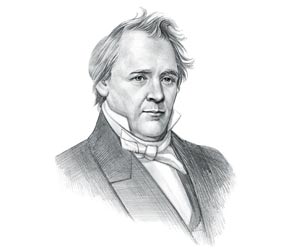|
|
|
|
|
The militant anti-slavery activist led a group of 21 armed men to seize weapons and ammunition from a federal armory at Harpers Ferry, enough to equip an army, and then lead a slave rebellion in the South. In the battle for the arsenal John Brown was captured by U.S. marines led by Colonel Robert E. Lee and and Lieutenant J.E.B. Stuart. He was tried and found guilty of murder, treason, and inciting a slave insurrection. He was hung on December 2, 1859, but his name was immortalized in the song "John Brown's Body Lies A-Mouldering in the Grave".
John Brown's Raid on
Harpers Ferry: Harpers Ferry
Harpers Ferry for kids: The Armory
and Arsenal
John Brown's Raid on Harpers Ferry
for kids:
What's the difference between an Armory and an Arsenal?
John Brown's Raid on Harpers
Ferry John Brown had been involved in the violent border war known as "Bleeding Kansas" during which he had received considerable publicity. The national economic depression, caused by the Panic of 1857 made it difficult to raise funds for the militant anti-slavery activists. If he could seize the weapons he could equip an army. He would be able to lead a slave rebellion in the south. His intention was to also establish a stronghold in the Southern mountains which could be used by fugitive slaves on their hazardous journey to freedom.
John Brown's Raid on Harpers
Ferry for kids: The "Secret Six"
What happened during John Brown's Raid on Harpers Ferry? Preparation
for the Raid
What happened during John Brown's Raid on Harpers Ferry? The
Followers
What happened during John Brown's Raid on Harpers Ferry? The Raid Meanwhile the raiders had taken over the arsenal and taken hostages. The local militia were the first to become involved in the Battle of Harpers Ferry, aided by the townspeople. Part of the plan was the assumption that local slaves would join the raiders, but this failed to happen. John Brown and his followers had their escape route cut off by the militia who surrounded the Armory and Arsenal at Harpers Ferry. The raiders took nine of the hostages and moved to the armory's small fire engine house. On Tuesday, October 18, Colonel Robert E. Lee ordered Lieutenant Israel Green and Lieutenant J.E.B. Stuart and their men to storm the engine house. The engine house was taken and the Marines began taking prisoners. Five raiders escaped during the battle and were never captured. Ten of the raiders were killed by the militia. During the battle Lieutenant Israel Green seriously wounded John Brown with his sword. The surviving raiders were taken eight miles to the prison at Charles Town.
John Brown's Raid on Harpers Ferry for kids:
The Trial of John Brown The name of the presiding over the trial was Judge Andrew Parker. The name of the prosecutors were Charles Harding and Andrew Hunter. The Charlestown lawyers Thomas C. Green and Lawson Botts were appointed defense counsel for John Brown but replaced, at Brown's request, by lawyers Samuel Chilton of Washington, DC, and Hiram Griswold of Ohio. On October 31, the jury found John Brown guilty on all counts of murder, inciting a slave insurrection and treason against the Commonwealth of Virginia. On November 2, 1859 Judge Andrew Parker sentenced John Brown to death by hanging. Following additional trials, Shields Green, John A. Copeland, John E. Cook, Edwin Coppoc, Aaron D. Stevens and Albert Hazlett were also hanged for their part in the Raid on Harpers Ferry.
John Brown's Raid on
Harpers Ferry: The Hanging The scaffold was prepared in a field on the edge of Charlestown. The route to the place of execution was guarded by troops and cannon and strangers were prohibited from entering the town. The scaffold itself was completely surrounded by soldiers. The hanging of John Brown was witnessed by only a few. Admittance to his hanging was severely restricted, due to fears that attempts would be made to free him. Newspaper reporters were however, allowed to witness the hanging and gruesome details were reported by the media. According to one reporter at the scene his "body jerked and quivered" for a full five minutes. His body was claimed by his wife, Mary Brown and he was buried in North Elba, New York.
John Brown's Raid on Harpers Ferry for kids:
The Effects of
John Brown's Raid on Harpers Ferry The widespread publicity surrounding the raid and the death of John Brown increased sympathies to the abolition cause in the North and their were cries for the immediate emancipation of slaves The anti-slavery factions in the North tolled bells for John Brown and he was proclaimed a martyr of the cause The pro-slavery factions in the south welcomed his execution reiterating the verdict of the trial that John Brown was a traitor to the Union who had encouraged a slave rebellion Southerners were shocked and outraged and linked John Brown to what they called the "Black Republican" Party of the North led by Abraham Lincoln Fear of a victory for the Republican Party, and the possible election of Lincoln, began talk of the Secession of the South John Brown's Raid on Harpers Ferry ultimately hastened the advent of the Civil War and was one of the Causes of the Civil War For additional information refer to the John Brown Biography and Timeline |
| US American History |
| 1850-1865: Secession Era |
|
|
|
|
|
First Published2016-04-19 | |||
|
Updated 2018-01-01 |
Publisher
Siteseen Limited
| ||
|
|

